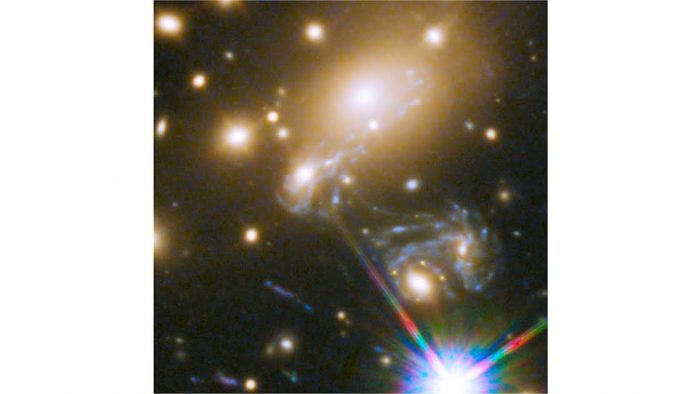A new technique to measure the expansion rate of the Universe may serve as a tool to help scientists more accurately determine the Universe’s age and better understand the cosmos. An international team of researchers that includes two Stony Brook University professors, Simon Birrer, PhD, and Anja von der Linden, PhD, highlighted their data based on the technique in a paper published in Science.
The research team used images from the Hubble Space Telescope of Supernova Refsdal, discovered by University of Minnesota scientist Patrick Kelly in 2014. It is named after astronomer Sjur Refsdal, who created a theory in 1964 on how to measure the Hubble constant – also known as Hubble’s law, which describes that galaxies are moving away from Earth at speeds proportional to their distance, so the further they are the faster the move away from Earth. Refsdal is the first supernova in which this measurement theory was put into practice.
Professor Kelly led the study, assembling an international team. Birrer was involved with the analysis and overall robustness of the measurement study, specifically working on constraining the small-scale dark matter distribution and the positional constraints on the images of the supernova, and their effect on the time-delay prediction. Von der Linden was part of the team that originally discovered SN Refsdal and prepared the follow-up Hubble observations.
There are two precise measurements of the expansion of the Universe, or Hubble constant: calculations from nearby observations of supernovae, and using cosmic microwave background (radiation) that began to steam freely shortly after the Big Bang. However, these two measurements differ by approximately 10 percent, which is the point of debate on current theories about the makeup and age of the Universe.
The team calculated the expansion rate of the Universe by using data from four different images of the Supernova Refsdal explosion event in 2014. Scientists worldwide had correctly predicted that the supernova would appear at a new position in 2015, and the telescope then captured a fifth image. These multiple images appeared because the supernova was gravitationally lensed by a galaxy cluster, a phenomenon in which mass from the cluster bends light. By using the time delays between the appearances of the images the research team was able to measure the Hubble Constant.
The study provides a measurement of the expansion rate consistent with expectations from the cosmic microwave background. The measurement technique and findings may also contribute to settling the longstanding debate among scientists regarding their disagreements on measurements of the current expansion rate of the Universe.
“The measurement of the expansion rate of the universe is a rollercoaster,” says Birrer, Assistant Professor in the Department of Physics and Astronomy. “While a few years ago most strong lensing measurements yielded higher values in tension with the cosmic microwave background estimates, more recent estimates and revised methodology has resulted in lower values. Our research corroborates a trend, yet does not provide the last word on the expansion rate.”
Knowing the Hubble Constant is knowing the age of the universe. Birrer explains that the findings described in the Science paper “provide a new and completely independent measurement of the age of the Universe, and that by knowing the absolute scale and relative expansion, we can infer the age of the Universe.”
The age of the Universe is about 13.6 billion years, when the cosmic microwave background inferred value of the Hubble constant is correct, or about 12.6 billion years, if the Cepheid-based local distance ladder value is correct.
“The prediction and subsequent observation of the fifth image of Supernova Refsdal was a great success of our cosmological model based on General Relativity and the mysterious dark matter,” adds von der Linden, Associate Professor in the Department of Physics and Astronomy. “Now, these data have allowed multiple teams to further refine their models of how dark matter is distributed in galaxy clusters, yielding a precise measurement of the Hubble constant from a lensed supernova.”
Central to the research and successful measurement of the Hubble constant is a measurement of the time delay between multiply arriving images of the supernova. The researchers address this point in an accompanying paper published in The Astrophysical Journal, also lead by Kelly. They explain that the time delay is directly proportional to the absolute scales in the observer-deflector-supernovae system. Knowing the time delay precisely and reconstruction the matter distribution of the lens enabled them to constrain a distance. This measurement is completely independent from other approaches in measuring the Hubble constant.
Professor Vivian Miranda from Stony Brook’s C.N. Yang Institute for Theoretical Physics, who was not involved in the current work, but contributed to an earlier, less precise estimate of the Hubble constant from the same supernova, commented: “This team has now established a new, exciting way of measuring the Hubble constant, which will add to our endeavor to understand the cause of the Hubble tension. I congratulate them on their work.”
Birrer and von der Linden are now working on the Legacy Survey of Space and Time (LSST), to be conducted with the newly built Vera C. Rubin Observatory. The LSST will discover many more lensed quasars and supernovae. Birrer has a leading role in the efforts to measure the Hubble constant from the LSST-discovered systems.
The research was funded primarily by NASA through the Space Telescope Science Institute and the National Science Foundation.





